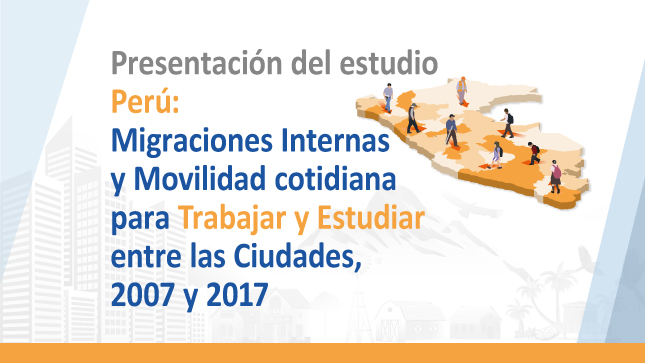Study of domestic migration and everyday mobility to work and study between cities of Peru was presented in Arequipa
Nota de prensa
7 de July de 2023 - 11:45 a. m.
The National Institute of Statistics and Informatics (INEI) of Peru and the Latin America and Caribbean Demographic Centre (CELADE)- Population Division, as part of the Economic Commission for Latin America and the Caribbean (ECLAC), presented in the city of Arequipa the research “Peru: Domestic migration and everyday mobility to work and study between cities, 2007 and 2017”.
This event was performed in the headquarters of the San Pablo Catholic University in charge of the Chief of the INEI, Dante Carhuavilca Bonett, who was accompanied of a board of commentators composed of Jorge Rodríguez Vignoli, Senior investigator of the Latin America and Caribbean Demographic Centre CELADE – CEPAL; Hugo González Coltrinari, representative of the United Nations Population Fund– UNFPA Peru and Carlos Leyton Muñoz, main researcher of the Center for Regional Development Studies– CEDER.
Change in the migratory trends
In its presentation of the Chief of the INEI highlighted that nowadays due to the predominant urban composition of the country’s population that is almost 80%, the highest intensity of the migratory tendencies is between cities, displacing the previous migration trend from countryside to the city. Therefore, during the period 2002-2007, the migrant population between the countryside to the city was of 622 884 persons, decreasing in the period 2012-2017, to 592 666 persons, which means a reduction of 30 218 persons. Meanwhile, the migrant population between cities went from 753 714 in the period 2002-2007 to 1 422 413 persons in the period 2012-2017, it means it grew in 668 699 persons.
Big cities attract migrant population
The chief of the INEI stressed that although the predominant migration is between cities, just 15 cities are attractive in migratory terms, among them outstand Lima, Arequipa, Trujillo, Tacna, Moquegua and Tarapoto. It should be noted that talking of big cities; this revelation ratifies the concentration of resources and opportunities in them, far beyond of the problems they face.
He added that the vast majority of small cities are expellers, which sets the direction of public policies, since all kind of deficits that cause this expeller condition is against the exercise of rights and the 2030 Agenda premise for the sustainable development of not left nobody behind.
Cities that attract migrants rejuvenate its population
The chief of the INEI outstood that the migration also modifies the composition of the population and tend to rejuvenate the attractive cities because the young people represent the greater proportion of the immigrant population and ends to favoring them because these cities receive the contribution and the thrust of population groups in working and studying age. Meanwhile, the small and medium cities expellers of population, have difficulties to retain their young population and keep depending population such as older people and children in school age, among others, which difficult their development.
He also added that the concentration of educational opportunities in the big cities is also expressed in regular displacements (daily, weekly and even monthly) to them of particularly superior education students that meet their education needs in the places where they live.
Finally, he emphasized that these results and others exposed in the document, are useful for the national bodies dealing with territorial and urban development for local authorities, particularly of metropolitan areas and cities in order to make the demographic projections of the cities and for academics in urban issues, among other public at large.